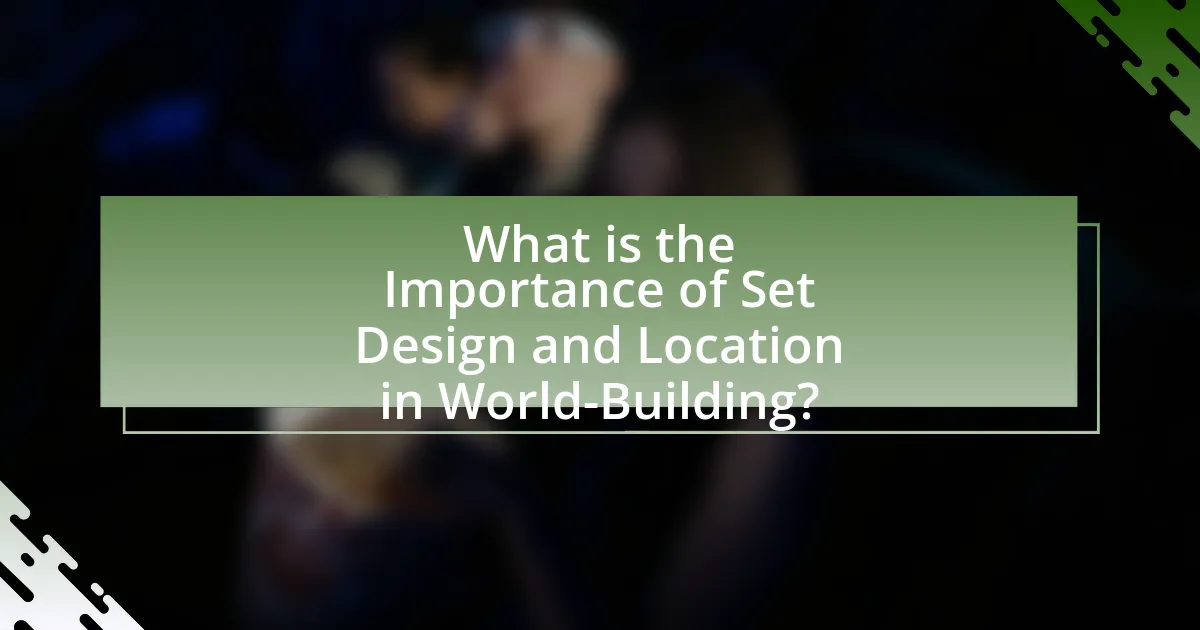Set design and location are essential components of world-building that significantly enhance storytelling in film and theater. Effective set design establishes the visual and emotional tone of a narrative, while carefully chosen locations provide authenticity and context, influencing audience engagement and perception. Key elements of set design, such as color, texture, and spatial arrangement, contribute to character development and interactions, while location selection shapes the narrative’s cultural and thematic dynamics. The article explores the interplay between set design and location, the psychological effects of color, practical considerations for material selection, and best practices for creating immersive environments that resonate with audiences.

What is the Importance of Set Design and Location in World-Building?
Set design and location are crucial in world-building as they create immersive environments that enhance storytelling. Effective set design establishes the visual and emotional tone of a narrative, allowing audiences to connect with the characters and plot on a deeper level. For instance, in film and theater, meticulously crafted sets can evoke specific time periods or cultures, influencing audience perception and engagement. Locations, whether real or imagined, provide authenticity and context, grounding the story in a believable world. Research indicates that well-designed environments can significantly impact viewer emotions and perceptions, as seen in studies on spatial presence in media. Thus, set design and location are integral to crafting compelling narratives that resonate with audiences.
How does set design contribute to the overall narrative?
Set design significantly contributes to the overall narrative by visually establishing the story’s context, mood, and character dynamics. It creates an immersive environment that reflects the themes and emotions of the narrative, guiding audience perception and engagement. For instance, a dark, cluttered set can evoke feelings of tension or chaos, while a bright, open space may suggest freedom or optimism. This visual storytelling element enhances the audience’s understanding of character motivations and relationships, as seen in productions like “The Great Gatsby,” where opulent set designs underscore themes of wealth and excess. Thus, effective set design is integral to conveying the narrative’s essence and enriching the viewer’s experience.
What elements of set design enhance storytelling?
Elements of set design that enhance storytelling include color, texture, spatial arrangement, and props. Color influences mood and can signify themes or character emotions; for example, warm colors may evoke comfort while cool colors can create tension. Texture adds depth and realism, allowing audiences to feel the environment’s authenticity, as seen in gritty urban settings versus lush natural landscapes. Spatial arrangement guides audience focus and can symbolize relationships between characters, such as a large distance indicating conflict. Props serve as narrative devices, providing context and backstory, like a family photo that reveals character history. Collectively, these elements create a cohesive visual narrative that supports and enriches the story being told.
How does set design influence audience perception?
Set design significantly influences audience perception by establishing the visual context and emotional tone of a production. Effective set design can evoke specific feelings, enhance storytelling, and shape audience interpretations of characters and themes. For instance, a minimalist set may create a sense of isolation, while a richly detailed environment can immerse viewers in a particular time and place, as seen in productions like “The Great Gatsby,” where opulent set design reflects the extravagance of the era. Research indicates that well-designed sets can enhance audience engagement and emotional responses, as evidenced by studies showing that immersive environments lead to greater viewer investment in the narrative.
Why is location selection crucial in world-building?
Location selection is crucial in world-building because it shapes the narrative, influences character development, and establishes the thematic tone of the story. The chosen locations can dictate the cultural, social, and economic dynamics within the world, impacting how characters interact and evolve. For instance, a story set in a bustling metropolis will differ significantly in atmosphere and character behavior compared to one set in a desolate wasteland. This variance is supported by the fact that specific settings can evoke particular emotions and responses from the audience, enhancing immersion and engagement. Therefore, thoughtful location selection is essential for creating a believable and compelling world that resonates with the audience.
What factors should be considered when choosing a location?
When choosing a location, factors such as accessibility, environmental context, cultural significance, and logistical considerations must be evaluated. Accessibility ensures that the location can be reached easily by cast and crew, impacting production efficiency. Environmental context, including natural landscapes and urban settings, influences the visual storytelling and thematic elements of the project. Cultural significance can enhance authenticity and resonate with the audience, while logistical considerations, such as availability of resources and local regulations, affect the feasibility of the production. These factors collectively contribute to the effectiveness of set design and location in world-building.
How does location impact the authenticity of the world?
Location significantly impacts the authenticity of the world by providing a tangible context that influences cultural, social, and environmental elements. For instance, a film set in a bustling urban environment will reflect different societal dynamics compared to one set in a rural landscape, thereby shaping the narrative’s credibility. Historical accuracy is also enhanced when locations are chosen based on their real-world counterparts; for example, using actual historical sites can lend authenticity to period dramas. Furthermore, geographical features, such as mountains or rivers, contribute to the world’s believability by grounding the story in recognizable landscapes, which can evoke genuine emotional responses from the audience.
What role does set design play in character development?
Set design plays a crucial role in character development by visually representing a character’s personality, background, and emotional state. The environment crafted through set design can reflect a character’s inner struggles, aspirations, and relationships, thereby enhancing the audience’s understanding of the character. For instance, a cluttered, dimly lit room may signify a character’s chaotic life or mental state, while a bright, organized space can indicate stability and success. This visual storytelling element allows viewers to make deeper connections with characters, as the set becomes an extension of their identities and experiences.
How can set design reflect a character’s personality?
Set design can reflect a character’s personality by visually representing their traits, emotions, and social status through the arrangement and choice of elements within a space. For instance, a cluttered and chaotic environment may indicate a character’s disorganized mind or tumultuous life, while a minimalist and sleek design can suggest sophistication and control. Specific details, such as color schemes, furniture styles, and decorative items, can further enhance this reflection; for example, warm colors and personal mementos may convey warmth and nostalgia, while cold, metallic tones might suggest detachment or ambition. This alignment between set design and character traits is supported by studies in visual storytelling, which emphasize that environments can serve as extensions of character, influencing audience perception and emotional engagement.
In what ways does set design influence character interactions?
Set design significantly influences character interactions by shaping the physical and emotional context in which characters engage. The arrangement of space, props, and visual aesthetics can dictate the dynamics of relationships, as seen in various theatrical and cinematic productions. For example, a cramped setting may heighten tension and conflict between characters, while an open space can foster collaboration and intimacy. Additionally, specific design elements, such as color and texture, can evoke particular emotions, further impacting how characters relate to one another. Studies in theater and film have shown that environments designed to reflect a character’s internal state can enhance audience understanding of their interactions, thereby reinforcing the narrative.
How do set design and location work together in world-building?
Set design and location collaborate to create a cohesive and immersive world in storytelling. Set design establishes the visual and thematic elements of a narrative, while location provides the real-world context that enhances authenticity. For instance, a meticulously crafted set can reflect the cultural and historical aspects of a location, making the fictional world more believable. The synergy between these elements is evident in films like “Blade Runner,” where the futuristic set design complements the urban landscape of Los Angeles, reinforcing the film’s dystopian themes. This integration of set design and location is crucial for engaging audiences and deepening their connection to the story.
What challenges do creators face in set design and location selection?
Creators face several challenges in set design and location selection, primarily including budget constraints, logistical issues, and creative limitations. Budget constraints often restrict the materials and locations available, forcing creators to compromise on their vision. Logistical issues, such as accessibility and permits, can hinder the selection of ideal locations, impacting the overall production schedule. Additionally, creative limitations arise when the chosen set or location does not align with the narrative or aesthetic goals, leading to potential inconsistencies in world-building. These challenges are critical as they directly influence the authenticity and effectiveness of the visual storytelling in a project.

What are the key components of effective set design?
The key components of effective set design include functionality, aesthetics, and coherence with the narrative. Functionality ensures that the set serves its intended purpose, allowing actors to move and interact naturally within the space. Aesthetics involve the visual appeal and style of the set, which should align with the overall theme and mood of the production. Coherence with the narrative means that the set design must support and enhance the story being told, providing context and depth to the characters and their environment. These components are essential for creating an immersive experience that resonates with the audience and effectively communicates the intended message of the production.
How do color schemes affect the mood of a set?
Color schemes significantly influence the mood of a set by evoking specific emotional responses. For instance, warm colors like red and orange can create feelings of warmth, excitement, or aggression, while cool colors such as blue and green often evoke calmness, tranquility, or sadness. Research by the Institute for Color Research indicates that people make subconscious judgments about a person, environment, or product within 90 seconds of initial viewing, and between 62% to 90% of that assessment is based on color alone. This demonstrates that color choices in set design are crucial for shaping audience perception and emotional engagement.
What psychological effects do colors have on viewers?
Colors significantly influence viewers’ emotions and perceptions. For instance, red often evokes feelings of excitement or urgency, while blue tends to promote calmness and trust. Research by Andrew Elliot and Markus Maier in their study “Color and Psychological Functioning: A Review of Theoretical and Empirical Work” published in 2014 highlights that colors can affect mood, behavior, and even cognitive performance. Yellow is associated with happiness and energy, whereas green is linked to tranquility and health. These psychological effects are crucial in set design and location, as they can enhance storytelling and audience engagement by strategically using color to evoke desired emotional responses.
How can color choices enhance thematic elements?
Color choices can enhance thematic elements by evoking specific emotions and reinforcing narrative concepts. For instance, warm colors like red and orange can signify passion or danger, while cool colors such as blue and green often represent calmness or nature. Research in color psychology indicates that colors can influence mood and perception; for example, a study by Andrew Elliot and Markus Maier published in the journal “Emotion” demonstrates that red can increase feelings of excitement and urgency. By strategically using color palettes, set designers can create immersive environments that align with the story’s themes, thereby deepening the audience’s emotional engagement and understanding of the narrative.
What types of materials are commonly used in set design?
Common materials used in set design include wood, metal, fabric, foam, and plastics. Wood is frequently utilized for constructing frames and platforms due to its versatility and strength. Metal is often employed for structural elements and fixtures, providing durability. Fabric is used for drapery, backdrops, and soft furnishings, allowing for varied textures and colors. Foam is popular for creating lightweight props and scenery, while plastics are used for a range of applications, including set pieces and decorative elements. These materials are chosen for their specific properties that enhance the visual storytelling in productions.
How do different materials affect the visual impact of a set?
Different materials significantly influence the visual impact of a set by altering texture, color, and light interaction. For instance, materials like wood can evoke warmth and authenticity, while metal can impart a modern or industrial feel. The choice of fabric, such as velvet versus cotton, affects the richness and depth of color, impacting the overall aesthetic. Additionally, reflective surfaces can enhance lighting effects, creating dynamic visual experiences. Research indicates that the material composition of a set can enhance audience engagement by aligning with thematic elements, as seen in productions like “The Lion King,” where natural materials reflect the story’s connection to the African landscape.
What are the practical considerations for material selection?
Practical considerations for material selection include factors such as durability, cost, availability, and suitability for the intended environment. Durability ensures that materials can withstand the stresses of use, while cost affects budget constraints. Availability impacts the feasibility of sourcing materials in a timely manner, and suitability relates to how well materials fit the aesthetic and functional requirements of the set design. For instance, using weather-resistant materials for outdoor sets is crucial to maintain visual integrity over time.
How can technology enhance set design and location choices?
Technology enhances set design and location choices by providing advanced tools for visualization, simulation, and collaboration. For instance, 3D modeling software allows designers to create detailed virtual environments, enabling them to experiment with various layouts and aesthetics before physical construction begins. Additionally, augmented reality (AR) and virtual reality (VR) technologies facilitate immersive experiences, allowing stakeholders to explore set designs in a simulated space, which aids in decision-making. Furthermore, location scouting has been revolutionized by drone technology, which offers aerial views and detailed imagery of potential sites, making it easier to assess suitability and logistics. These technological advancements streamline the design process, reduce costs, and improve the overall quality of set design and location selection.
What role does digital technology play in modern set design?
Digital technology plays a crucial role in modern set design by enabling the creation of immersive and visually stunning environments that enhance storytelling. Advanced software tools, such as 3D modeling and rendering programs, allow designers to visualize and manipulate set elements with precision, facilitating rapid prototyping and iteration. For instance, virtual reality (VR) and augmented reality (AR) technologies enable designers to simulate and experience sets before physical construction, ensuring that the final product aligns with the creative vision. Additionally, digital technology streamlines collaboration among teams, allowing for real-time updates and adjustments, which is essential in the fast-paced production environment of film and theater. This integration of technology not only improves efficiency but also elevates the overall quality of set design, making it a vital component in the world-building process.
How can virtual reality aid in location scouting?
Virtual reality can significantly aid in location scouting by providing immersive, 3D simulations of potential sites, allowing filmmakers and designers to visualize spaces before physically visiting them. This technology enables users to explore various environments interactively, assessing factors such as lighting, spatial dynamics, and aesthetic appeal in real-time. Studies have shown that using virtual reality in pre-production can reduce location scouting time by up to 30%, as it allows for more informed decision-making based on detailed virtual representations rather than relying solely on photographs or descriptions.

What best practices should be followed in set design and location selection?
Best practices in set design and location selection include thorough research, alignment with the narrative, and attention to detail. Researching historical accuracy and cultural relevance ensures authenticity, while aligning the set design with the story’s themes enhances immersion. Attention to detail, such as color schemes and props, creates a cohesive visual experience. For instance, a study by the University of Southern California found that well-designed sets can significantly enhance audience engagement and emotional response, demonstrating the impact of effective set design on storytelling.
How can collaboration improve set design outcomes?
Collaboration can significantly improve set design outcomes by integrating diverse perspectives and expertise, leading to more innovative and functional designs. When designers, directors, and technical teams work together, they can share ideas and feedback, which enhances creativity and problem-solving. For instance, a study by the American Institute of Architects found that collaborative design processes can increase project efficiency by up to 30%, demonstrating that teamwork not only fosters creativity but also streamlines execution. This synergy allows for a more cohesive vision that aligns with the narrative and emotional tone of the production, ultimately resulting in a more immersive experience for the audience.
What roles do different team members play in the design process?
In the design process, different team members play distinct roles that contribute to the overall success of a project. Designers are responsible for creating the visual elements, ensuring that the aesthetics align with the project’s vision. Art directors oversee the artistic aspects, guiding the design team to maintain a cohesive look and feel. Set decorators focus on the details within the set, selecting props and furnishings that enhance the narrative. Location scouts identify and secure appropriate filming locations that fit the story’s requirements. Each member’s expertise is crucial; for instance, a study by the American Society of Interior Designers highlights that collaboration among these roles leads to more innovative and effective design solutions.
How can feedback loops enhance the design process?
Feedback loops enhance the design process by facilitating continuous improvement through iterative evaluation and adjustment. This mechanism allows designers to gather insights from users and stakeholders, which can be integrated into subsequent design phases, leading to more effective and user-centered outcomes. For instance, studies have shown that incorporating user feedback during the design phase can increase user satisfaction by up to 30%, as it ensures that the final product aligns closely with user needs and preferences. By systematically analyzing feedback, designers can identify strengths and weaknesses in their work, ultimately refining their designs to better meet objectives and enhance overall quality.
What are common pitfalls to avoid in set design and location choices?
Common pitfalls to avoid in set design and location choices include neglecting the narrative context, overlooking practical logistics, and failing to consider audience perception. Neglecting the narrative context can lead to sets that do not enhance the story, as seen in productions where the environment contradicts character motivations or plot developments. Overlooking practical logistics, such as accessibility and safety, can result in delays and increased costs, as evidenced by numerous productions that faced setbacks due to inadequate planning. Lastly, failing to consider audience perception can diminish the overall impact of the design; for instance, sets that are too abstract may confuse viewers rather than immerse them in the story.
How can overcomplicated designs detract from storytelling?
Overcomplicated designs can detract from storytelling by overwhelming the audience and obscuring the narrative’s core message. When visual elements are excessively intricate, they can distract viewers from the characters and plot, leading to confusion rather than engagement. Research indicates that simplicity in design enhances comprehension and emotional connection, as seen in studies on visual communication, which show that audiences retain information better when presented with clear and straightforward visuals. Therefore, effective storytelling relies on set designs that support rather than complicate the narrative.
What mistakes should be avoided in location selection?
Mistakes to avoid in location selection include neglecting audience accessibility, overlooking local regulations, and failing to consider the thematic relevance of the location. Audience accessibility is crucial; if a location is difficult to reach, it can limit attendance and engagement. Local regulations, such as zoning laws and permits, can significantly impact the feasibility of using a location, leading to potential legal issues. Additionally, the thematic relevance of the location should align with the narrative; a mismatch can confuse the audience and weaken the overall impact of the world-building. For instance, a historical drama set in a modern urban environment may disrupt the viewer’s immersion, highlighting the importance of cohesive location choices.
What practical tips can enhance set design and location effectiveness?
To enhance set design and location effectiveness, utilize a cohesive color palette that aligns with the narrative’s mood and themes. This approach ensures visual consistency and strengthens the emotional impact of the scenes. For instance, studies in color psychology indicate that specific colors can evoke particular feelings; blue often conveys calmness, while red can signify tension. Additionally, incorporating practical elements such as texture and layering in set design can create depth and realism, making the environment more immersive for the audience. Research shows that well-designed sets can significantly enhance viewer engagement, as evidenced by productions that prioritize detailed environments, leading to higher audience retention rates.




